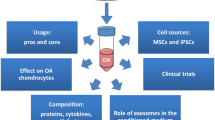Abstract
It is well established that a full-thickness articular cartilage defect is repaired with a fibrocartilaginous tissue, cells of which are derived from undifferentiated mesenchymal stem cells in the bone marrow. To characterize the repair cells biochemically, full-thickness defects were created in rabbit knee joints and the repair tissues taken at 3, 6, and 12 weeks after surgery. The repair cells were cultured and examined biochemically to investigate the effects of four exogenous growth factors with regard to the metabolism of type II collagen and proteoglycans. A significant increase of carboxy-terminal type II procollagen peptide production was observed in the conditional medium of the repair cells, especially taken at 6 weeks after surgery, in the presence of each growth factor. Glycosaminoglycan content was also increased and proteoglycan synthesis stimulated. The repair cells taken at the early stage of the repair process could originally have more activity of type II collagen synthesis, and the growth factors used could enhance the differentiation of the repair cells in vitro.
Similar content being viewed by others
Author information
Authors and Affiliations
Additional information
Accepted: 3 November 1997
Rights and permissions
About this article
Cite this article
Nakajima, H., Goto, T., Horikawa, O. et al. Characterization of the cells in the repair tissue of full-thickness articular cartilage defects. Histochemistry 109, 331–338 (1998). https://doi.org/10.1007/s004180050233
Issue Date:
DOI: https://doi.org/10.1007/s004180050233




